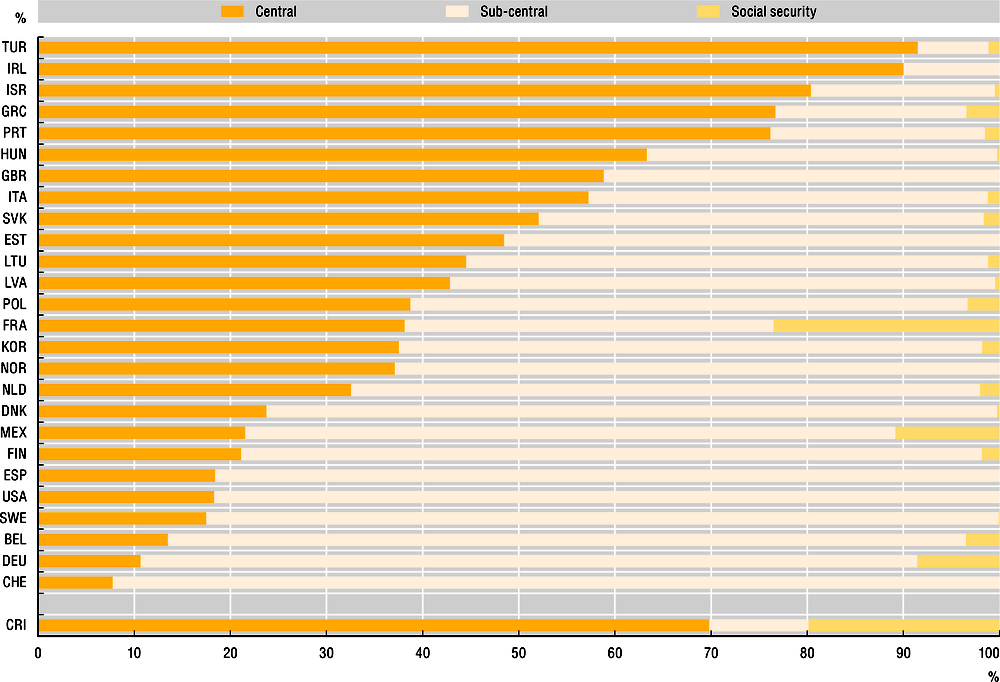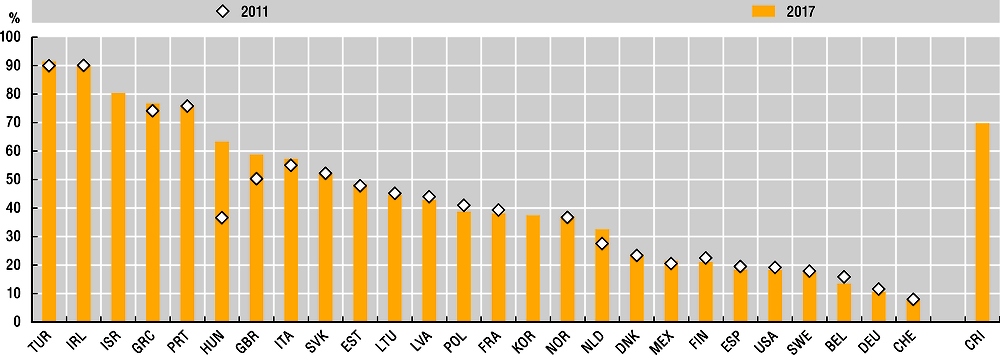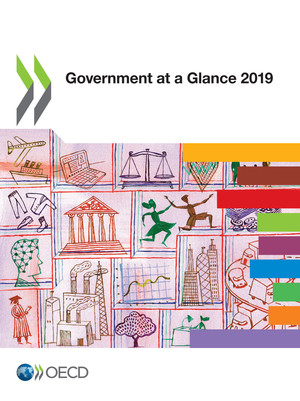copy the linklink copied! General government employment across levels of government
The proportion of staff employed at sub-central levels of government is an indicator of the level of decentralisation of public administrations. Larger shares of government employees employed at the sub-central level typically means that local and regional governments have more responsibility for providing public services. While decentralisation can increase the responsiveness of government to local needs and priorities, it can also result in variations in service delivery within countries.
In 2017, more general government employees were employed at the sub-central level than at the central level, though this varies across countries. Some federal states, such as Belgium, Germany and Switzerland, characteristically demonstrate higher levels of general government employees working at the sub-central level. Others with a unitary state model, such as Ireland, Israel and Turkey, tend to concentrate most general government workers at the central level.
Between 2011 and 2017, the percentage of general government staff employed at the central level has remained relatively stable, continuing a trend observed during the period 2009-14. This suggests that in countries that experienced adjustments to government employment levels over this period (see Employment in general government), these adjustments were, on the whole, equally shared at central and sub-central levels and have not markedly changed since the 2007-08 financial crisis. Only Hungary has experienced significant change over this period, where the share of government staff employed at the central level has increased by 27 p.p. This increase was due to the reorganisation of the territorial public administration during this period. Additionally, the proportion of government staff employed at the central level in the United Kingdom as well as in the Netherlands grew by 8.5 p.p. and 5 p.p., respectively, between 2011 and 2017. In both cases, this was the result of an increase in the staff employed at the central level and a decrease in the staff at the sub-central levels that produced an overall reduction of the general government staff over this period.
Data were collected by the International Labour Organization (ILO), ILOSTAT (database). The data are based on the System of National Accounts (SNA) definitions and cover employment in central and sub-central levels of government. Sub-central government is comprised of state and local government including regions, provinces and municipalities. Together the central and sub-central levels comprise general government. In addition, countries provided information on employment in the social security funds component of general government, which include all central, state, and local institutional units whose principal activity is to provide social benefits. As social security funds refer to different levels of government, employment in this category has been recorded separately unless otherwise stated. However, in most countries, with the exceptions of France, Germany and Mexico, social security funds employ few staff and represent a small percentage of the total workforce. Data represent the total number of persons employed directly by each of those different levels of government and social security funds institutions. The following countries are federal states in the dataset: Belgium, Germany, Mexico, Spain (considered a quasi-federal country), Switzerland and the United States.
Further reading
OECD (2019), Recommendation of the Council on Public Service Leadership and Capability, https://legalinstruments.oecd.org/en/instruments/OECD-LEGAL-0445OECD (2017), Skills for a High Performing Civil Service, OECD Public Governance Reviews, OECD Publishing, Paris, https://doi.org/10.1787/9789264280724-en
OECD (2016), Engaging Public Employees for a High Performing Civil Service, OECD Public Governance Reviews, OECD, Paris, https://doi.org/10.1787/9789264267190-en.
Figure notes
Data for Australia, Austria, Canada, Chile, Iceland, Japan, Luxembourg, New Zealand and Slovenia are not available. Data for Estonia, Greece, Spain and Costa Rica are based on the Labour Force Survey. Social security funds are not separately identified (i.e. recorded under central and/or sub-central government) for Estonia, Ireland, Norway, Spain, Switzerland, the United Kingdom and the United States. Data for France, Hungary, Mexico and Switzerland are for 2016. On data for Israel, see https://doi.org/10.1787/888932315602. For Poland other non-profit institutions (NPIs) have been redistributed among central and sub-central levels of government.
3.4. Data for Lithuania are for 2010 rather than 2011.
Metadata, Legal and Rights
https://doi.org/10.1787/8ccf5c38-en
© OECD 2019
The use of this work, whether digital or print, is governed by the Terms and Conditions to be found at http://www.oecd.org/termsandconditions.




